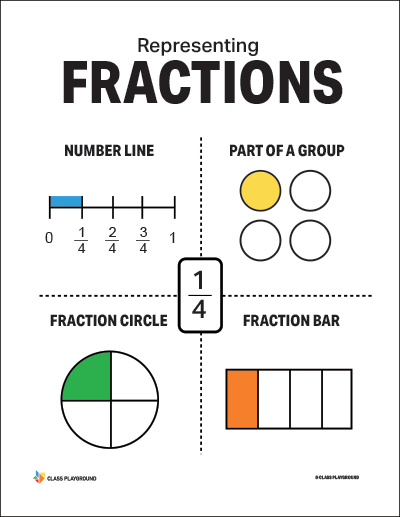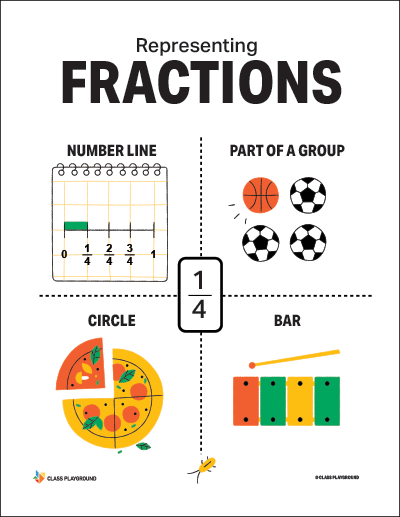What are Fractions?
Fractions represent parts of a whole. They’re written with two numbers: the numerator (how many parts we have) over the denominator (how many equal parts the whole is divided into). For example, in 3/4 there are three parts out of four equal pieces.
Why Teach Fractions?
This concept is everywhere—sharing food, measuring ingredients, telling time, and comparing sizes. In math, it connects directly to operations, ratios, and later work with algebra. Strong understanding helps students reason flexibly about numbers and prepares them for more advanced topics.
Strategies
- Connect to real life: Start with familiar contexts (sharing a pizza, dividing a chocolate bar) so students see why this skill matters.
- Use visual models: Show parts of a whole with paper folding, drawings, or manipulatives.
- Focus on the denominator: Emphasize that it names equal parts of the same-sized whole. Keep the “whole” consistent when comparing values.
- Compare with benchmarks: Encourage reasoning with 0, 1/2, and 1. Ask: “Is 3/8 closer to 0 or 1/2? Why?”
- Build precise language: Use terms like equivalent, unit fraction, numerator/denominator, greater than/less than in discussion and feedback.
- Progress step by step: Move from unit fractions (like 1/4) to non-unit fractions (3/4), then to equivalence, comparison, and simple operations.
Common Misconceptions
- “Bigger denominator means bigger value”: Clarify that more total parts means smaller pieces (1/8 < 1/4).
- Comparing unlike wholes: Keep the whole the same size when comparing or combining parts.
- Adding numerators and denominators straight across: Model why 1/3 + 1/3 = 2/3 (not 2/6) using strips or circles.
Classroom Activities
- Paper Folding: Fold and label halves, thirds, fourths, etc. Compare sizes and discuss equivalence.
- Fraction Strips: Use Fraction Strips to line up pieces, find equivalents (2/6 = 1/3), and compare lengths.
- Fraction Circles: Explore parts of a whole with Fraction Circles to see how pieces combine.
- Number Line Placement: Place values on a Number Line to strengthen the idea of parts as numbers with order and distance.
- Recipe Remix: “Double it” or “make half a batch” to practice scaling in a real-world context.
- Word Problems Lab: Write short contexts (sharing, measuring, comparing) and solve with a chosen model (strips, circles, or line).
Guided Instruction
- Equivalence: Use concrete models first, then transition to multiplication/division rules for generating equivalent parts.
- Comparison: Start with common denominators or benchmark reasoning before moving to cross-multiplication shortcuts.
- Operations: Model addition/subtraction with like denominators using strips/circles; introduce unlike denominators after a strong foundation.
Conclusion
Fractions become easier to understand when students explore them with visuals, real-world contexts, and step-by-step practice. With clear instruction and hands-on activities, learners can build a strong foundation for future math success.



